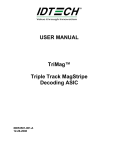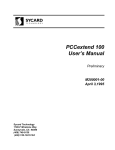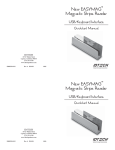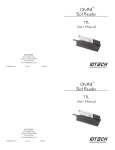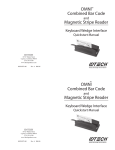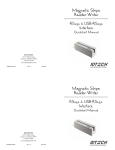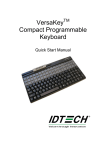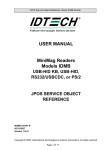Download ID TECH MiniMag II
Transcript
TM New MINIMAG Magnetic Stripe Reader Port Powered Quickstart Manual ID TECH 10721 Walker Street Cypress, California 90630 (714) 761-6368 www.idtechproducts.com 80066508-001 Rev. B R04/06 #418 AGENCY APPROVED MESSAGE DATA FORMAT Specifications for subpart B of part 15 of FCC rule for a Class A computing device. <SS1><DATA1><ES><SS2><DATA2><ES><SS3><DATA3> <ES><CR> LIMITED WARRANTY ID TECH warrants to the original purchaser for a period of 24 months from the date of invoice that this product is in good working order and free from defects in material and workmanship under normal use and service. ID TECH’s obligation under this warranty is limited to, at its option, replacing, repairing, or giving credit for any product which has, within the warranty period, been returned to the factory of origin, transportation charges and insurance prepaid, and which is, after examination, disclosed to ID TECH’s satisfaction to be thus defective. The expense of removal and reinstallation of any item or items of equipment is not included in this warranty. No person, firm, or corporation is authorized to assume for ID TECH any other liabilities in connection with the sales of any product. In no event shall ID TECH be liable for any special, incidental or consequential damages to Purchaser or any third party caused by any defective item of equipment, whether that defect is warranted against or not. Purchaser’s sole and exclusive remedy for defective equipment, which does not conform to the requirements of sales, is to have such equipment replaced or repaired by ID TECH. For limited warranty service during the warranty period, please contact ID TECH to obtain a Return Material Authorization (RMA) number & instructions for returning the product. Where <SS1>, <SS2>, and <SS3> are start sentinels for Track 1, Track 2, and Track 3, and <ES> is the end sentinel for all tracks. ISO format: <SS1> is % <SS3> is + <SS2> is ; <ES> is ? CADMV format: <SS1> is % <SS3> is ! <SS2> is ; <ES> is ? <DATAX> is the decoded data for Track X. It is the character “E” if the magnetic data on Track X is not valid. THIS WARRANTY IS IN LIEU OF ALL OTHER WARRANTIES OF MERCHANTABILITY OR FITNESS FOR PARTICULAR PURPOSE. THERE ARE NO OTHER WARRANTIES OR GUARANTEES, EXPRESS OR IMPLIED, OTHER THAN THOSE HEREIN STATED. THIS PRODUCT IS SOLD AS IS. IN NO EVENT SHALL ID TECH BE LIABLE FOR CLAIMS BASED UPON BREACH OF EXPRESS OR IMPLIED WARRANTY OF NEGLIGENCE OF ANY OTHER DAMAGES WHETHER DIRECT, IMMEDIATE, FORESEEABLE, CONSEQUENTIAL OR SPECIAL OR FOR ANY EXPENSE INCURRED BY REASON OF THE USE OR MISUSE, SALE OR FABRICATIONS OF PRODUCTS WHICH DO NOT CONFORM TO THE TERMS AND CONDITIONS OF THE CONTRACT. 8 RS-232 PARAMETERS Baud Rate Data Bits Parity Stop Bits Hand-Shaking 9600 8 None 1 X-ON/X-OFF (11h/13h) 7 ©2006 International Technologies & Systems Corporation. The information contained herein is provided to the user as a convenience. While every effort has been made to ensure accuracy, ID TECH is not responsible for damages that might occur because of errors or omissions, including any loss of profit or other commercial damage. The specifications described herein were current at the time of publication, but are subject to change at any time without prior notice. ID TECH is a registered trademark of International Technologies & Systems Corporation. MiniMag and Value through Innovation are trademarks of International Technologies & Systems Corporation. SPECIFICATIONS TROUBLE SHOOTING PROCEDURES Power Requirements: 5 to 12 VDC/7mA. Operating Current: 5 mA typical (including LED)<9mA peak (<1ms). The troubleshooting process can be simplified by reviewing these reader operations. Operating Temperature: 32° F to 131° F (0° C to 55° C). Storage Temperature: -22° F to 158° F (-30° C to 70° C). Relative Humidity: 10% to 90% non-condensing. Magnetic Head Life: 1,000,000 passes minimum. Rail and Cover Life: 1,000,000 passes minimum. Magnetic Stripe Encoding & Formats: Two-frequency coherent phase (F2F) compatible with ISO 7811 ANSI, AAMVA, and California DMV. Once the unit has indicated a “good read,” then proceed to check the interface configuration. Installation of the reader is generally easy and trouble free, here are some considerations if problems occur. Does the host COM port baud rate, number of data bits & parity match the reader? See RS232 Parameters. Maximum Number of Tracks: 3 tracks. Swipe Speed: 3 to 60 inches per second, bidirectional. Card Thickness: .015 to .045 inches. Dimensions: Length: Once it has been confirmed that the unit is correctly powered, swipe a credit card. The LED will go off while decoding, then light green to indicate a “good read,” or red to indicate a “bad read.” Is the host set-up for card reader operation and is the card reader application running? Check the application set-up parameters. 3.56 inches (90mm). Width: 1.34 inches (34mm). Height: 1.10 inches (28mm). Weight: 5.5 oz. (with cable). Cable Length: 6-foot straight cable. 1 Does the configuration of the reader’s magnetic stripe data output match the host application data input requirements? The application may need to be configured to match. 6 OPERATION DESCRIPTION 1. Connect the MiniMag reader cable to the 9-pin male serial port on a computer. Insure the reader cable connector is fully seated with the computer. The MiniMag™ compact magnetic stripe reader can read 1, 2, or 3 tracks of magnetic stripe information. Power consumption is low; standard RS-232 ports can power it. Operating current is less than 9mA maximum for a 3-track configuration. 2. Run an RS-232 communication program (such as HyperTerminal). Select the serial port to which the reader cable has been connected. The application needs to open the RS-232 port with DSR set to HIGH. (A typical communication program sets DSR to HIGH by default.) 3. The green LED will light to indicate the reader is powered. 4. Set the baud rate at 9600, 8 data bits, 1 stop bit, and no parity. 5. The LED is normally GREEN (reader ready). Slide a card, in either direction, through the reader slot, with the magnetic stripe facing the magnetic head (opposite the LED side of the reader). 6. The LED will be off during a card read swipe. The GREEN LED will be on after a good read operation; otherwise, the LED will be RED for 1/2 second, then return to GREEN. The decoding electronics are based on MagChip ASIC technology designed for use with magnetic stripe cards encoded with F2F ANSI and ISO-conforming data. The MiniMag reliably decodes data encoded within ANSI and ISO standards, on both high and low coercivity magnetic media. The circuit is designed to read cards demagnetized down to 30% or 40% of ISO and ANSI signal levels, on Track 1 and Track 3 or Track 2 respectively. These reading characteristics are designed to insure that the MiniMag will reliably read ‘real world’ cards. In order to insure reliable reading under varying conditions, the MiniMag will read magnetic media at speeds from 3 inches per second (IPS) to 60 IPS with typical accelerations. The output is standard RS-232. 7. The data on the card will be shown on the screen. Check the communication parameters if the data on the screen is not correct. NOTE: Sending data to the reader while swiping a card will cause a bad read. 5 2 HOST CONNECTIONS POWER-ON INITIALIZATION The Port-Powered MiniMag reader is connected to a 9-pin male serial port on a host (such as a PC) using a DB9 female connector. Pinout designations are as follows: The MiniMag will always transmit an identification string within 2 seconds after it powers up. The identification string has the following format: PIN SIGNAL <compressed part number><revision information> 2 3 4 5 TXD RXD DSR GND The <compressed part number> is eight characters and the <revision information> is three characters. (Supply Voltage in) SLEEP & WAKE-UP The reader uses a sleep mode to save power when not in use. The reader wakes-up when a card is swiped. After the card data is transmitted the reader returns to the sleep mode. The LED will remain on to show the “ready to read” condition. The reader also wakes-up 5ms after receiving a character from the RS232 port. The reader will stay awake for about 100ms to receive any commands from the host. The reader returns to sleep mode after commands are processed. 3 4






